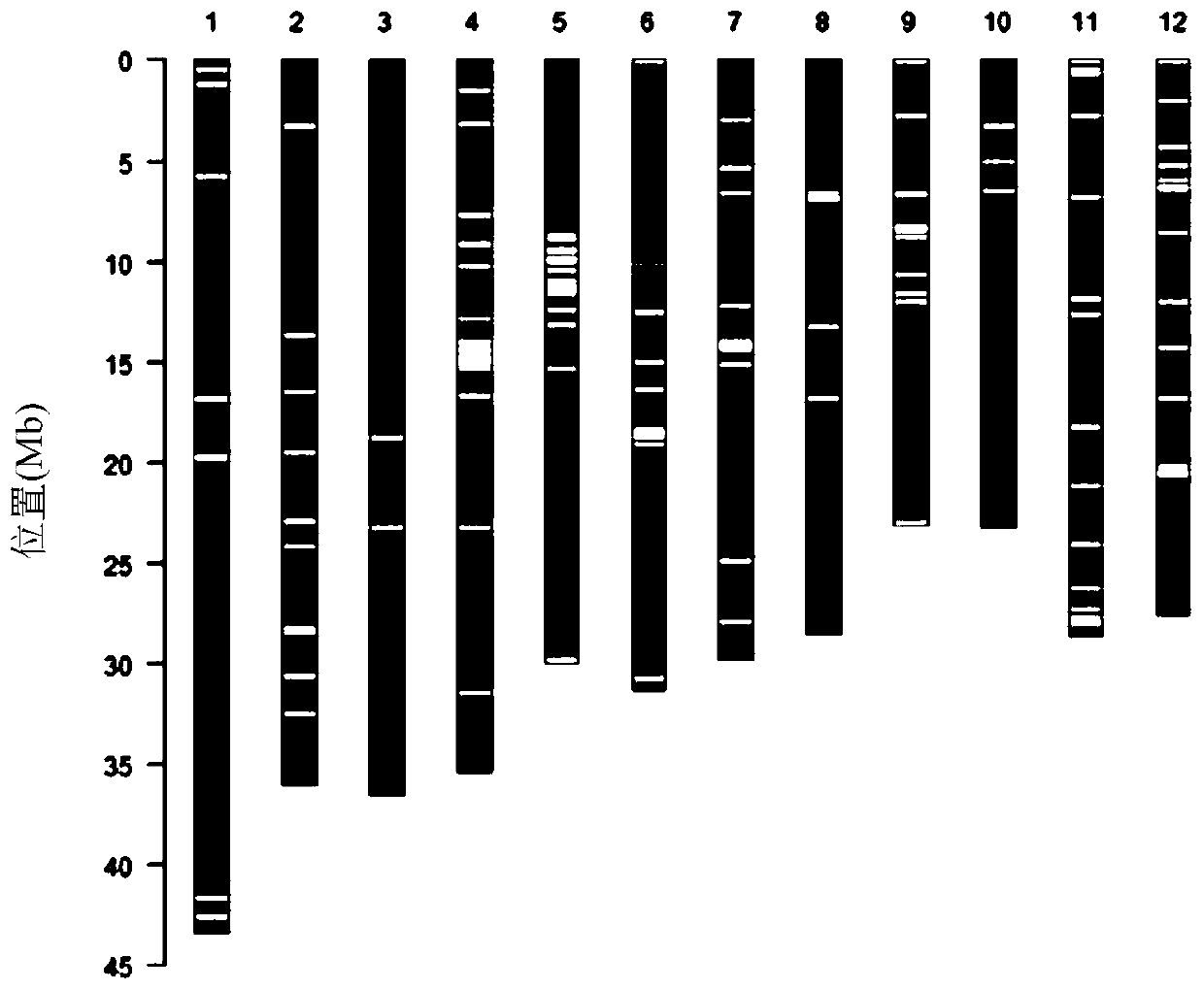Rice genome recombinant nucleic acid fragment reccr012069 and its detection method
A technology of recombinant nucleic acid and genome, applied in the field of recombinant nucleic acid fragments and their detection, can solve the problems of low efficiency and long time, and achieve the effects of excellent cold tolerance and improvement of rice blast resistance.
- Summary
- Abstract
- Description
- Claims
- Application Information
AI Technical Summary
Problems solved by technology
Method used
Image
Examples
Embodiment 1
[0042] Example 1 Breeding of Recombinant Plants Introduced with Rice Blast Resistant Genome Fragments
[0043] The materials used in this example are rice 'Kongyu 131' and rice 'Gumei No. 4'.
[0044] Rice 'Gumei 4' has good blast resistance, and it is speculated that the Pi2 region of chromosome 6 may play a key role in the blast resistance of this material.
[0045] During the selection and breeding of recombinant plants, the recombinant plants were selected using molecular markers, and the molecular markers used for foreground selection were screened. Download the 9,559,000 to 10,990,000 DNA sequences of chromosome 6 with reference to the Rice Nipponbare Genome MSU / TIGR Annotation Version 6.1. SSR sites in the above sequences were scanned using SSRLocator software. The Primer Premier 3.0 software was used to design primers for the found SSR sites, and a total of 162 primer pairs were designed. The polymorphisms of the above primer pairs in 'Gumei 4' and 'Kongyu 131' w...
Embodiment 2
[0055] Example 2 Determination of Homologous Recombination Fragments After Introducing Rice Blast Resistance Genome Fragments
[0056] In order to determine the size of the introduced fragment of the rice blast resistance genome, the homozygous single plant of the imported fragment of 'Kongyu 131' was sequenced by the homologous recombination fragments on both sides of the target genome fragment. The recombinant nucleic acid fragment of the rice blast resistance genome contained in CR012069 was named RecCR012069.
[0057] The results of the rice genome-wide breeding chip RICE60K preliminarily determined that the upstream homologous recombination fragment of RecCR012069 was located between the markers F0610288021CT and R0610355182TC, and the downstream homologous recombination fragment was located between the markers R0610435056GA and R0610486650CT.
[0058] At the same time, using Miseq sequencing technology, the whole genomes of 'Kongyu 131', 'Gumei No. 4' and CR012069 wer...
Embodiment 3
[0071] Example 3Identification of rice blast resistance after introduction of 'Kongyu 131'
[0072] In order to identify the resistance effect, the new line CR012069, the recurrent parent 'Kongyu 131', the rice blast resistant variety Gumei No. 4 (as a positive control), and the rice blast susceptible variety Lijiang Xintuan Heigu ( As a negative control) for indoor planting, the following methods are used for identification after being cultivated to the 3-4 leaf stage:
[0073] The 14-7322-1 rice blast strain isolated from Heilongjiang in 2014 was selected as the inoculated strain. The strain is stored at -20°C by the sorghum grain method. Before use, the preserved sorghum grains are taken out to a potato dextrose medium (PDA) plate for activation (PDA: 200g of peeled potatoes, 20g of glucose, 15g of agar powder, and distilled water to 1L), After 5 days of light culture at 28°C, take the fresh mycelium block with a diameter of 5mm and transfer it to the sorghum grain mediu...
PUM
| Property | Measurement | Unit |
|---|---|---|
| diameter | aaaaa | aaaaa |
Abstract
Description
Claims
Application Information
 Login to View More
Login to View More - R&D
- Intellectual Property
- Life Sciences
- Materials
- Tech Scout
- Unparalleled Data Quality
- Higher Quality Content
- 60% Fewer Hallucinations
Browse by: Latest US Patents, China's latest patents, Technical Efficacy Thesaurus, Application Domain, Technology Topic, Popular Technical Reports.
© 2025 PatSnap. All rights reserved.Legal|Privacy policy|Modern Slavery Act Transparency Statement|Sitemap|About US| Contact US: help@patsnap.com



